Header image from National Park Service.gov, Relay, Connecticut
Connecticut was admitted at the fifth sate on Jan 9, 1788.
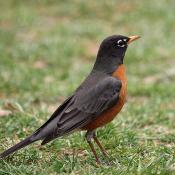 Bird: Robin -The robin is considered a symbol of spring, often the first migratory bird to return north. There is a Quebec superstition that whoever sees the first robin of spring will have good luck. American robins have exceptionally keen eyesight that allows them to see the tiny disturbances in the soil that indicate where worms are moving. This is how robins find worms, though they also use their senses of hearing and touch as part of their hunting as well. State bird of Connecticut, Michigan, Wisconsin
Bird: Robin -The robin is considered a symbol of spring, often the first migratory bird to return north. There is a Quebec superstition that whoever sees the first robin of spring will have good luck. American robins have exceptionally keen eyesight that allows them to see the tiny disturbances in the soil that indicate where worms are moving. This is how robins find worms, though they also use their senses of hearing and touch as part of their hunting as well. State bird of Connecticut, Michigan, Wisconsin
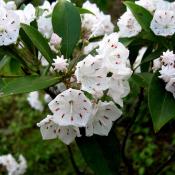 Flower: Mountain Laurel – Also called the calico-bush, or spoonwood (native Americans used to make spoons from the wood), it is a broadleaved evergreen shrub in the heather family. All parts of the plant are poisonous. State flower of Connecticut and Pennsylvania
Flower: Mountain Laurel – Also called the calico-bush, or spoonwood (native Americans used to make spoons from the wood), it is a broadleaved evergreen shrub in the heather family. All parts of the plant are poisonous. State flower of Connecticut and Pennsylvania
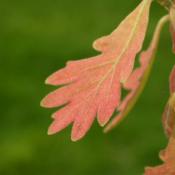 Tree :White Oak – White oak has tyloses that give the wood a closed cellular structure, making it water- and rot-resistant. Because of this characteristic, white oak is used by coopers to make wine and whiskey barrels as the wood resists leaking. Also, by federal regulation, bourbon whiskey must be aged in charred new oak (generally understood to mean specifically American white oak)
Tree :White Oak – White oak has tyloses that give the wood a closed cellular structure, making it water- and rot-resistant. Because of this characteristic, white oak is used by coopers to make wine and whiskey barrels as the wood resists leaking. Also, by federal regulation, bourbon whiskey must be aged in charred new oak (generally understood to mean specifically American white oak)
It has also been used in construction, shipbuilding, agricultural implements, and in the interior finishing of houses. USS Constitution is made of white oak and southern live oak, conferring additional resistance to cannon fire.
State Quarter
from theus50.com
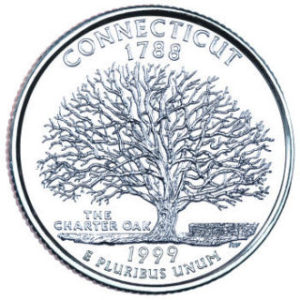
Being the subject of a legend as old as the colony itself, the Charter Oak of Hartford, Connecticut is one of the most famous white oaks in America. An image of the tree now adorns the reverse side of the Connecticut state quarter. If not for the famed “Charter Oak”, Connecticut – and this country in general – might be a very different place than it is today.
The Charter Oak was an unusually large white oak tree growing on Wyllys Hyll in Hartford, Connecticut. According to tradition, a British representative for King James II, challenged Connecticut’s government structure and demanded its surrender. In the middle of the heated discussion, with the Charter on the table between the opposing parties, the candles were mysteriously snuffed out, darkening the room. When visibility was reestablished, the Connecticut Charter had vanished. Heroic Captain Joseph Wadsworth saved the Charter from the hands of the British and concealed it in the safest place he could find – in a majestic white oak. The oak became a symbol of American independence and is commemorated on the Connecticut State Quarter. In 1935, for Connecticut’s tercentennial, it was also depicted on both a commemorative half dollar and a postage stamp.
This famous tree, “The Charter Oak,” finally fell during a great storm on August 21, 1856.
Capital: Hartford
Nickname: Constitution State.
Connecticut is nicknamed the “Constitution State” because The Fundamental Orders was the first constitution to be adopted by the American colonies in 1639. It established the structure and boundaries of the newly formed government and ensured the rights of free men to elect their public officials—principles that were later embraced within the U.S. Constitution.
Also called the “Nutmeg State” and “Land of Steady Habits”.
Motto: He Who Transplanted Still Sustains
State insect Praying Mantis.
Connecticut Facts and Trivia
The state is named after the Connecticut River, which bisects the state and is a major river in the U.S. The word Connecticut is derived from the Native American word quinetucket, meaning “besides the long, tidal river”.
Connecticut borders Massachusetts to the north, Rhode Island to the east, Long Island Sound to the south and New York to the west.
Only Delaware and Rhode Island are smaller than Connecticut.
Arriving in 1614, the first settlers in the state were the Dutchmen. The Dutch were fur traders who built a fort near present-day Hartford.
The first English settlers of Connecticut arrived in 1636, settling the plantations of Windsor, Hartford and Wethersfield.
In colonial New Haven cut pumpkins were used as guides for haircuts to ensure a round uniform style. Because of this fashion, these New Englanders were nicknamed “pumpkin-heads.”
In 1705, copper was discovered in Simsbury. Later, the copper mine became the infamous New-Gate Prison of the Revolutionary War. Doctor Samuel Higley of Simsbury started the first copper coinage in America in 1737.
Cattle branding in the United States began in Connecticut when farmers were required by law to mark all of their pigs.
Connecticut is home to the first hamburger (1895), Polaroid camera (1934), helicopter (1939), and color television (1948).
The first automobile law was passed by the state of CT in 1901. The speed limit was set at 12 miles per hour.
Connecticut and Rhode Island never ratified the 18th Amendment (Prohibition).
Connecticut and Rhode Island have no county governments. All county governments in Connecticut were abolished on October 1, 1960.
Cities:
Thomas Sanford made the first friction matches in Beacon Falls in 1834.
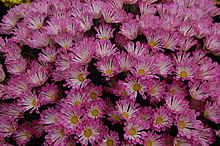 Bristol, CT is considered the “Mum City” of the USA because of the many Chrysanthemums grown and sold to various states and Canada.
Bristol, CT is considered the “Mum City” of the USA because of the many Chrysanthemums grown and sold to various states and Canada.
Danbury, An important military depot for the American Revolutionary armies was burned and looted in April 1777 by the British under Major General William Tryon.
The first telephone book ever issued contained only fifty names. The New Haven District Telephone Company published it in New Haven in February 1878.
The first lollipop-making machine opened for business in New Haven in 1908. George Smith named the treat after a popular racehorse.
The Scoville Memorial Library is the United States oldest public library. The library collection began in 1771, when Richard Smith, owner of a local blast furnace, used community contributions to buy 200 books in London. Patrons could borrow and return books on the third Monday of every third month. Fees were collected for damages, the most common being “greasing” by wax dripped from the candles by which the patrons read.
On April 9, 1810, a Salisbury town meeting voted to authorize the “selectmen draw upon the town treasurer for the sum of one hundred dollars” to purchase more books for the Scoville Memorial Library collection, making the library the first publicly supported free town library in the United States.
Strange Laws:
In order for a pickle to officially be considered a pickle, it must bounce.
It is illegal to dispose of used razor blades.
In Hartford, you aren’t allowed to cross a street while walking on your hands.
In Waterbury, no beautician can hum, whistle, or sing while working on a customer.
It is illegal for fire trucks to exceed 25mph, even when going to a fire. (New Britain)
People:
- Dean Acheson, statesman
- Ethan Allan, American Revolutionary soldier
- Benedict Arnold, American Revolutionary general
- P. T. Barnum, showman
- Ann Baxter, actress
- Henry Ward Beecher, clergyman
- Polly Bergen, actress
- Ernest Borgnine, actor
- John Brown, abolitionist
- Gary Burghoff, actor
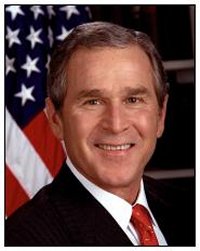 Bush George W., 43rd President of the U. S. Born in Hartford in 1946, the family moved to Texas in 1948.
Bush George W., 43rd President of the U. S. Born in Hartford in 1946, the family moved to Texas in 1948.- Art Carney, actor
- Karen and Richard Carpenter, singers
- Glenn Close, actress
- Samuel Colt, inventor
- Michael J Fox, actor
- Charles Goodyear, inventor
- Nathan Hale, American Revolutionary officer
- Katharine Hepburn, actress
- Ted Knight, actor
- Hope Lange, actress
- David Letterman, comedian, talk-show host
- Joe Lieberman, politician, V-P candidate
- Robert Mitchum, actor
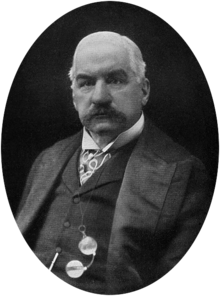 John Pierpont Morgan, financier
John Pierpont Morgan, financier- Paul Newman, actor
- Adam Clayton Powell, Jr., congressman
- Anthony Quinn, actor
- Rosalind Russell, actress
- Benjamin Spock, pediatrician
- Harriet Beecher Stowe, author
- Ed Sullivan, showman
- Noah Webster, lexicographer
- Joanne Woodward, actress
Music
Yankee Doodle (State Song )
Connecticut by Judy Garland and Bing Crosby
Kylie from Connecticut by Ben Folds
Connecticut Fun by Punkestra
The Wives Are In Connecticut by Carly Simon
Connecticut Snow by David Stephens
Callie’s Got Connections in Connecticut by Mad Tea Party
The Connecticut Song by Kristen Graves
Credits:
See Just fun facts.com
See Only In Your State.com
See The Fact File. org
See Ducsters.com
See History.com
See 50 states.com
See Mental Floss.com
See Tidbits of History.com/states for facts and trivia about all the states.
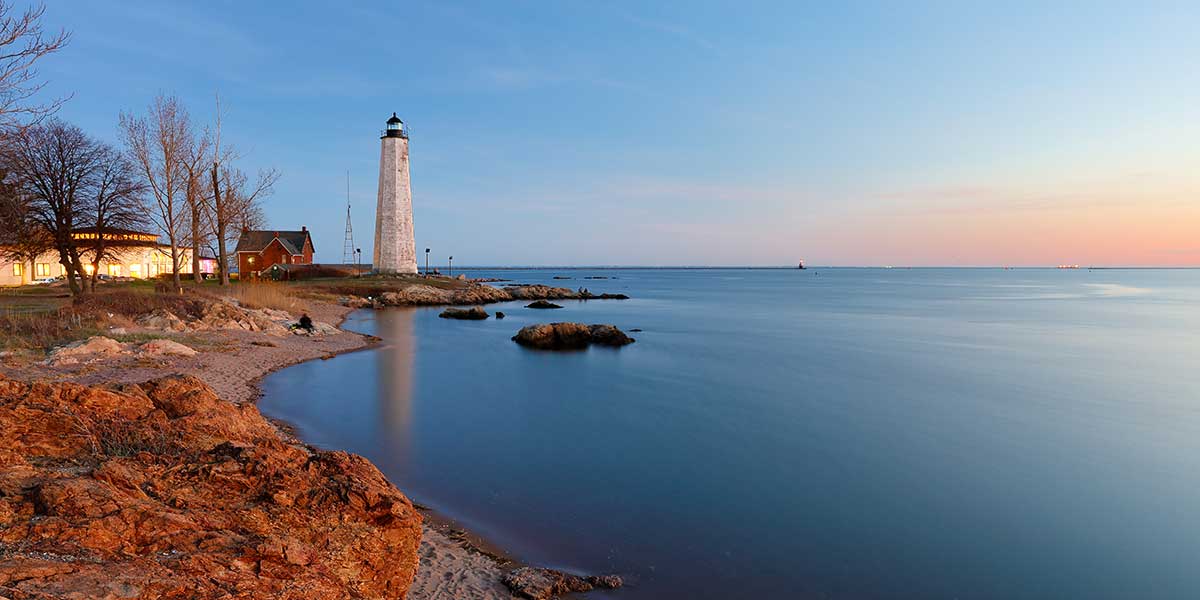
Pingback: This day in history, January 9